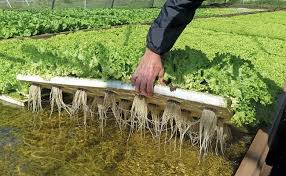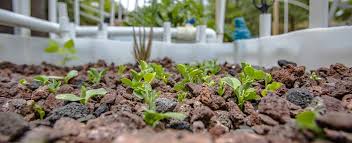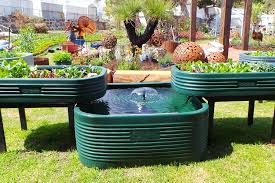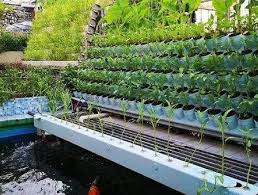Aquaponics is an innovative and sustainable farming method that combines aquaculture (raising fish) and hydroponics (growing plants in water) into a symbiotic ecosystem. This practice has gained popularity in recent years due to its ability to produce food efficiently while minimizing resource use.
The beauty of aquaponics lies in its simplicity: fish waste provides an organic nutrient source for the plants, and the plants help filter and clean the water for the fish. This self-sustaining cycle creates a balanced environment that can be set up in various locations, from backyards to urban rooftops, making it accessible for anyone interested in growing their own food.
As the global population continues to grow, traditional farming methods face challenges such as soil depletion, water scarcity, and the need for chemical fertilizers and pesticides. Aquaponics presents a viable solution to these issues by using less water than conventional farming methods, eliminating the need for harmful chemicals, and allowing for year-round production of both fish and vegetables.
This not only promotes sustainable agriculture but also contributes to food security, especially in urban areas where space for gardening is limited.
Starting an aquaponics system may seem daunting at first, but it can be broken down into manageable steps. Beginners can start small, using simple setups like aquaponic buckets or a small tank and grow bed, to learn the basics of this farming method.
Once you become comfortable with the process, you can scale up to larger systems that can produce a significant amount of food. This flexibility makes aquaponics suitable for anyone, whether you have a large backyard or just a small balcony.
One of the most appealing aspects of aquaponics is the variety of plants and fish you can grow. Common fish species include tilapia, catfish, and goldfish, while plants like lettuce, herbs, and tomatoes thrive in aquaponic systems.
This diversity allows you to tailor your aquaponics setup to your tastes and dietary preferences. Moreover, many aquaponic systems can be designed to work indoors, making it possible to grow fresh food year-round, regardless of the outdoor climate.
To ensure success in aquaponics, beginners must understand the essential components of the system: fish tanks, grow beds, pumps, and filtration systems. Each part plays a crucial role in maintaining the health of the fish and plants.
Monitoring water quality is vital, as factors such as pH, ammonia, nitrite, and nitrate levels directly affect the well-being of both fish and plants. Additionally, beginners should familiarize themselves with fish and plant requirements, including temperature, light, and nutrient needs, to create a thriving aquaponics environment.
Benefits of Aquaponics

1. Sustainable Food Production: Aquaponics combines aquaculture (raising fish) and hydroponics (growing plants in water), creating a sustainable food system. This method uses fewer resources, minimizes waste, and can produce both fish and vegetables in a small space.
2. Efficient Use of Water: Aquaponics systems use up to 90% less water than traditional farming. Water is recirculated between fish tanks and plant beds, reducing the need for constant water supply and ensuring efficient water use.
3. Chemical-Free Farming: Aquaponics relies on natural processes for nutrient cycling, eliminating the need for synthetic fertilizers and pesticides. This results in healthier food production and a reduced environmental impact.
4. Year-Round Production: Aquaponics systems can be set up indoors or in greenhouses, allowing for year-round crop production regardless of external weather conditions. This increases food availability and stability for growers.
5. High-Quality Produce: The fish waste in aquaponics serves as a nutrient-rich fertilizer for plants, leading to healthier and tastier produce. This method can yield higher-quality vegetables and fish compared to conventional farming.
6. Space Efficiency: Aquaponics systems can be implemented in urban environments, small backyards, or even indoors. This makes it an excellent option for individuals with limited space who want to grow their own food.
7. Educational Opportunities: Aquaponics provides a hands-on learning experience about sustainable practices, ecosystems, and food production. It can be an effective educational tool for schools and communities.
Basic Components of an Aquaponics System
1. Fish Tank: This is where the fish are raised. It needs to be appropriately sized for the fish species being cultivated and equipped with aeration systems to ensure optimal oxygen levels.
2. Grow Bed: Plants are grown in the grow bed, which can be filled with media (like gravel or clay pellets) or used as a floating raft system. The grow bed provides support for the plants and serves as a filtration system for the water.
3. Pump System: A pump is used to circulate water from the fish tank to the grow bed. This ensures that plants receive the nutrient-rich water from the fish waste while returning clean water back to the fish.
4. Filtration System: While the grow bed acts as a biofilter, additional filtration may be required to remove solid waste and improve water quality. This can include mechanical and biological filters.
5. Aeration System: An aeration system, such as air stones or diffusers, ensures that there is enough dissolved oxygen in the fish tank, which is crucial for fish health.
6. Drainage System: A drainage system allows excess water to return to the fish tank after passing through the grow bed. Proper drainage helps maintain water levels and prevents flooding.
How Aquaponics Works
1. Fish Waste Production: Fish produce waste that contains ammonia, which is toxic to them but rich in nutrients for plants.
2. Nitrification Process: Beneficial bacteria convert ammonia into nitrites and then into nitrates, which are less harmful to fish and serve as nutrients for plants. This biological filtration is essential for maintaining water quality.
3. Nutrient Uptake by Plants: The plants absorb the nitrates and other nutrients from the water, effectively cleaning it and utilizing it for growth. This process helps keep the water clean for the fish.
4. Water Recirculation: The cleaned water is then pumped back to the fish tank, completing the cycle. This closed-loop system maximizes resource efficiency and reduces waste.
5. Balanced Ecosystem: The key to a successful aquaponics system is maintaining a balanced ecosystem where fish, plants, and beneficial bacteria coexist. Monitoring water quality, pH levels, and nutrient concentrations is crucial for system health.
Choosing the Right Fish for Your System
1. Climate Considerations: Choose fish species that are suited to your local climate. Some species thrive in warmer waters, while others prefer cooler temperatures. For instance, tilapia are popular in warmer climates, while trout are better suited for cooler environments.
2. Growth Rate: Consider the growth rate of the fish. Fast-growing species like tilapia or catfish can provide quicker returns on investment and allow for more frequent harvests.
3. Size and Space Requirements: Ensure the fish species chosen fits well within the available space and tank size. Larger fish require more space and resources, while smaller species can be raised in compact systems.
4. Compatibility with Plants: Some fish can produce higher levels of waste, which can benefit plant growth. Research how well the chosen fish species can complement the plants being grown in the aquaponics system.
5. Local Regulations: Check local regulations regarding fish farming, as some species may require permits or have restrictions. It’s essential to comply with local laws to ensure successful operation.
6. Personal Preference: Consider your personal preferences for fish. If you plan to eat the fish, choose species that you enjoy. If the system is for ornamental purposes, select colorful or interesting species.
Read Also: 14 Medicinal Health Benefits of Arum maculatum (Wild Arum)
Selecting Plants for Aquaponics

1. Leafy Greens: Leafy greens like lettuce, spinach, and kale are excellent choices for aquaponics. They have a quick growth cycle, require minimal nutrients, and thrive in the nutrient-rich water produced by fish waste.
2. Herbs: Herbs such as basil, mint, and cilantro are ideal for aquaponics systems. They grow well in a variety of conditions and benefit from the nutrient availability in aquaponics.
3. Fruiting Vegetables: Plants like tomatoes, peppers, and cucumbers can also thrive in aquaponics. They require a bit more nutrients and care but can yield bountiful harvests when conditions are right.
4. Other Vegetables: Other options include radishes, beans, and peas. These vegetables can grow successfully in aquaponic systems and add variety to your harvest.
5. Avoiding Heavy Feeders: It’s essential to avoid heavy feeders like corn and potatoes in the early stages of your aquaponics setup. These plants may require more nutrients than fish waste can provide.
6. Compatibility: Consider the compatibility of plants with the chosen fish species. Some plants may require different pH or nutrient levels than what specific fish can tolerate.
Setting Up Your Aquaponics System
1. Choose a Location: Select a suitable location with access to sunlight, a water source, and a nearby power supply for pumps and aeration systems. Indoor setups should have adequate lighting.
2. Design the System: Decide on the type of aquaponics system (e.g., media-based, nutrient film technique, or deep water culture) that fits your space and goals. Each system has different requirements for water flow and plant support.
3. Set Up the Fish Tank: Install a fish tank with appropriate filtration and aeration systems. Make sure it is large enough to support the number of fish you plan to raise.
4. Install Grow Beds: Set up grow beds above or adjacent to the fish tank. Ensure they are equipped with drainage systems to allow water to flow back into the fish tank.
5. Install Pumps and Plumbing: Connect pumps to circulate water from the fish tank to the grow beds and back. Ensure all plumbing is secure and leak-free.
6. Add Substrate (if needed): If using a media-based system, fill the grow beds with suitable substrate (e.g., gravel, clay pellets) to support plant growth and biological filtration.
7. Introduce Fish and Plants: Start by cycling the system with fish, allowing beneficial bacteria to establish. Once the system is stable, introduce your selected plants.
Read Also: 12 Medicinal Health Benefits of Emilia Sonchifolia (lilac tasselflower)
Maintenance and Care of Your Aquaponics System

1. Monitor Water Quality: Regularly test pH, ammonia, nitrite, and nitrate levels to ensure they remain within optimal ranges. Adjust as necessary to maintain a healthy environment for fish and plants.
2. Feed the Fish: Provide a balanced diet appropriate for the fish species you are raising. Avoid overfeeding, as excess food can pollute the water.
3. Check for Pests and Diseases: Regularly inspect plants for signs of pests or diseases. Implement organic pest control methods to manage infestations without harming the fish.
4. Prune and Harvest: Regularly prune plants to encourage growth and ensure proper air circulation. Harvest crops as they mature to keep the system balanced.
5. Clean the System: Periodically clean filters and remove any debris or waste buildup in the fish tank and grow beds. Ensure that all components are functioning properly.
6. Maintain Equipment: Regularly check pumps, aeration systems, and lights to ensure they are operating effectively. Replace any faulty equipment to prevent system failure.
Common Challenges in Aquaponics
1. Water Quality Issues: Fluctuations in pH, ammonia, and nitrate levels can harm fish and plants. Regular testing and prompt corrective actions are crucial.
2. System Imbalance: An imbalance in the ecosystem can lead to fish stress or plant nutrient deficiencies. Maintaining a balanced ratio of fish to plants is essential.
3. Fish Health Problems: Fish can suffer from diseases or stress due to poor water quality, overcrowding, or incompatible species. Regular monitoring and proactive management can prevent issues.
4. Plant Growth Problems: Slow growth or nutrient deficiencies in plants can result from inadequate lighting, improper nutrient levels, or unsuitable plant selections. Adjustments may be needed to optimize growth conditions.
5. Technical Failures: Equipment failures, such as pump malfunctions, can disrupt the system. Regular maintenance and having backup systems in place can mitigate this risk.
6. Pests and Diseases: Pests can affect plant health, and diseases can spread quickly in aquaponics systems. Regular inspections and organic pest management strategies are essential.
Do you have any questions, suggestions, or contributions? If so, please feel free to use the comment box below to share your thoughts. We also encourage you to kindly share this information with others who might benefit from it. Since we can’t reach everyone at once, we truly appreciate your help in spreading the word. Thank you so much for your support and for sharing!

